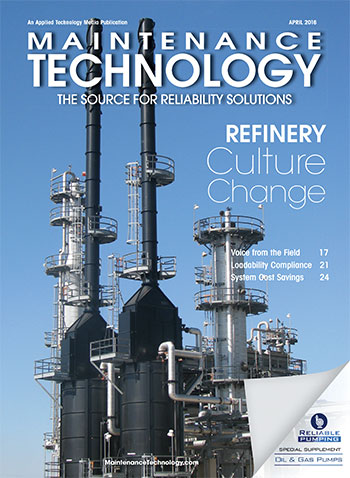These packages are added to your lubricants to help them do all that you want them to do.
These packages are added to your lubricants to help them do all that you want them to do.
By Ken Bannister, Contributing Editor
Symptom:
“Having implemented an in-house consolidation program, we hope to significantly reduce the number of lubricants that our site stocks and uses. We have a number of greases and gear lubricants of similar viscosity and want to know how to determine their compatibility when switching from one to another.”
Diagnosis:
The mixing of lubricants—greases or oils—is a major cause of equipment problems. For example, a lubricant containing acidic additives mixed with one containing base or alkaline additives can quickly neutralize the mixed product’s effectiveness and protective ability, and lead to catastrophic lubricant and bearing failure. Similarly, when changing to a new lubricant, depending on compatibility issues, you may or may not be required to flush the old product from the reservoir and bearings with neutral flushing oil prior to filling and using the new one.
{loadposition articlelube0213}
Prescription:
Before proceeding with a lubricant “swap,” ALWAYS consult with the manufacturer of the replacement product to determine if it has already been tested for compatibility with the old product, and if not, would the manufacturer be willing to do so on your behalf. If no information is available or forthcoming, and you’re unable to establish compatibility, you can conduct your own tests, as follows:
Note: RPVOT testing can be expensive. You could forego this procedure by having the manufacturer of the new lubricant recommend a neutral flushing oil (if you don’t have too many lube changeovers to complete).
When dealing with greases, a similar process is followed: Samples are mixed in 75:25 and 25:75 ratios then sent to the lab to test for consistency, dropping point and shear stability.
Understanding lubricant compatibility before a swap will protect against catastrophic failure due to incompatibility shortly after the changeover. MT
Lube questions? Ask Dr. Lube, aka Ken Bannister, author of the book Lubrication for Industry and the Lubrication section of the 28th edition Machinery’s Handbook. He’s also a Contributing Editor for Maintenance Technology and Lubrication Management & Technology. E-mail: doctorlube@atpnetwork.com.



By Ken Bannister, Contributing Editor
Symptom: “Dear Dr. Lube: In the past we’ve always used mineral oil to lubricate the ammonia-refrigerant compressors that operate our ice rinks. As part of our sustainability program, I have been asked to review the use of synthetic lubricants. Are these available for refrigeration compressors? Can I expect benefits to offset their cost?”
Diagnosis: The life of a compressor lubricant is not easy! A regular mineral-based oil can deteriorate quickly. Deterioration leads to oxidation-caused carbon, gum and varnish buildups that result in excessive wear of all mechanical moving parts, increased energy costs and reduced compressor efficiency and availability.
{loadposition articlelube0213}
Prescription: A variety of synthetic compressor fluids for large commercial ammonia refrigeration systems have been formulated to relieve many of the problems associated with volatile solvent-refined paraffinic and naphthenic mineral oils, including:
In large commercial refrigeration operations, temperatures can be lower than -60 F (-51 C). Synthetics provide the viscosity stability required for dealing with the extreme hot and cold temperatures. They’re also less soluble in ammonia refrigerant than their mineral counterparts and can significantly reduce oil consumption and subsequent refrigerant contamination effects.
Compared to typical mineral-based lubricants with a recommended maximum life of 3000 hours, synthetics are often rated for up to 8000 hours, thus reducing downtime, maintenance and environmental impact. Synthetic-oil manufacturers also claim energy savings of up to 4%. Your choice of synthetic type will usually vary among polyalphaolefins, alkyl benzines, polyol esters and polyalkylene glycols. Selection is based on compressor type, operating conditions, oil-separator efficiency and system design.
To learn if a synthetic is right for your application, discuss the refrigeration-system design with your lubricant supplier. Based on that information, the vendor can develop a business case with a return-on-investment statement that will allow you to determine if the change meets the needs of your sustainability program. MT
Lube questions? Ask Dr. Lube, aka Ken Bannister, author of the book Lubrication for Industry and the Lubrication section of the 28th edition Machinery’s Handbook. He’s also a contributing editor for Maintenance Technology and Lubrication Management & Technology. E-mail: doctorlube@atpnetwork.com.

Brought to you by:![]()
Follow mtmagazine on Twitter
